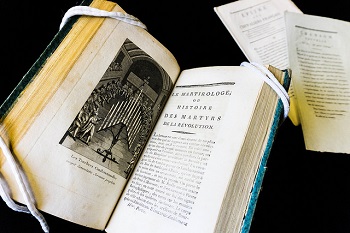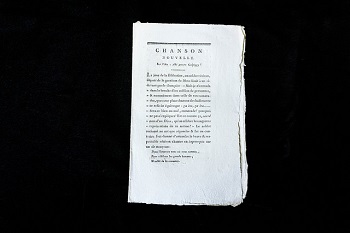UBC Library Partners with French Department on Revolution Pamphlet Collection
|
Le martirologe: ou L’histoire des martyrs de la Révolution by Jean-Gabriel Peltier (1760–1825)Photo credit: UBC Library Communications |
At the University of British Columbia (UBC), Vancouver, a partnership between the Department of French, Hispanic, and Italian Studies (FHIS) and the library will provide new levels of access to a growing collection of original pamphlets from the French Revolution.
UBC Rare Books and Special Collections (RBSC) Librarian Chelsea Shriver has been working closely with FHIS associate professor Joël Castonguay-Bélanger to expand the original collection of pamphlets acquired by the library more than 40 years ago. With funds from a former professor’s bequest, RBSC is purchasing more to form a significant corpus.
An upcoming digitization initiative will make the documents available to students, researchers, and the community as a whole, and a January 2019 research seminar will give students the opportunity to work directly with the pamphlets. A small exhibit, mounted around the same time, will allow the UBC and local Vancouver community to see items from the collection in historical context. Castonguay-Bélanger is also hoping to launch a parallel virtual exhibit, with research conducted by students. Historians will be invited to lecture on the subject as well.
BUILDING UBC’S COLLECTION
The first set of 111 pamphlets was purchased in the early 1970s from Hague-based Martinus Nijhoff Antiquarian Book Dealers. These documents, printed and circulated during the period of upheaval from 1789 to 1799, run the gamut from political material to entertainment.
The collection had been entered in the UBC library catalog since its acquisition, but items weren’t listed individually. A couple of years ago, Shriver told LJ, RBSC began thinking about how to make the underutilized collection more visible. She had worked with Castonguay-Bélanger on an earlier exhibition on the history of the book, and reached out to him about the possibility of digitizing and cataloging the material. Castonguay-Bélanger, however, had a larger vision.
There were many aspects of the project that interested him, said Castonguay-Bélanger, including giving visibility to an unknown collection and bringing it in line with French Revolution–era material held at institutions such as Chicago’s Newberry Library, the University of Florida, and Stanford University. “Our collection can contribute to a much bigger conversation that is going on in North America and in the world,” he said. "But why not take it a bit further and actually continue to acquire more material?"
The Dorothy Dallas Centre for Seventeenth and Eighteenth-century French Studies (endowed by former professor Dallas, who taught 17th-century French literature at UBC from 1933 to 1967) has funded speakers, conferences, a graduate fellowship, and research assistantships. Castonguay-Bélanger proposed a five-year partnership: FHIS would use some of the Dallas Centre resources toward the acquisition of more material and digitization of the corpus, and RBSC would provide matching funds. Both sides quickly agreed.
HANDS-ON HISTORY
As Shriver and Castonguay-Bélanger have moved forward with the project, its scope has grown to include an undergraduate seminar and a small exhibit.
The course, which Castonguay-Bélanger will teach in French in January 2019, will serve as an introduction to the French Revolution for many of the students, he noted—a vivid way to understand the decade of violent events. The material, Castonguay-Bélanger told LJ, will help bring that history to life.
“It's always the same challenge,” he said, “how to tell the story and understand an event that lasted so long, that doesn't have a very linear narrative.” It’s difficult to teach the French Revolution from one angle, he added, and working with the original material will offer insight beyond traditional reading.
“We're talking about a collection that is extremely varied in nature,” Castonguay-Bélanger explained. “We have small pamphlets of four pages, others that go up to 60 pages. We have political and very violent-toned pamphlets, we have writings from [Maximilien] Robespierre, [Jean-Paul] Marat, [Honoré Gabriel Riqueti, comte de] Mirabeau—very well-known political actors of the time.”
Notable items include a pamphlet titled La semaine memorable (The Week To Remember), written in July 1989 shortly after citizens stormed the Bastille, and Constitution de la République Française: proposée au peuple français par la Convention nationale (Constitution of the French Republic: Proposed to the French People by the National Convention), a 1795 document advancing the ideas of liberty, equality, safety, and ownership for all people regardless of their class or origin.
|
Chanson nouvelle: sur l’air: Ahi povero Calpiggy! published by Lefranc (1790)Photo credit: UBC Library Communications |
In addition to political writing, students will encounter more lighthearted fare, such as popular poems, songs, and plays, as well as satire including the Le Père Duchesne and La Mère Duchesne series, profanity-filled political commentary designed to provoke readers into action. “By encountering those prints they will get an understanding that during even the most bloody episodes of the French Revolution there were still plays being presented in the theaters,” said Castonguay-Bélanger. “The Parisians were trying to live their lives as it was happening.”
Students will not only learn about the collection’s contents but also be able to handle the documents. Such interaction with materials is not unusual, noted Shriver. Although RBSC, housed at the Irving K. Barber Learning Centre, is a closed-stack facility, UBC believes in hands-on access to much of its holdings.
“We are a research library, we're a public institution, and for us having our materials used in teaching and learning is really primary,” she told LJ. “We have undergraduate and graduate students come and handle materials from our 13th-century Bible to our modern archives…for a variety of classes and independent projects. That is something that we really put a lot of emphasis on, because these collections are for the students to use to aid in their learning, just as much as the circulating collections in our main humanities and social sciences library and our science and medicine library."
GROWING THE COLLECTION
Along with these planned events, Castonguay-Bélanger is helping acquire more material for the collection. In less than a year and a half, the partners have doubled the size of RBSC’s French Revolution holdings. “That's the fun part,” he noted. “I'm involved in selecting the material.”
"We rely on faculty to help us decide what is going to have the most impact in terms of teaching and research, what's going to be used immediately, what's most useful for courses for research,” explained Shriver. “This type of collaborative acquisition is a model of what we would do ideally for all kinds of subject areas.” Strong support from both the library and FHIS, she added, has given them a fair amount of autonomy when it comes to decisions about the collection.
While Shriver and Castonguay-Bélanger are advocates of hands-on learning, digitizing the collection will be a major component of the project. The time frame for that phase of the work has yet to be determined; as the collection grows, it will need to be evaluated for conservation prior to scanning, and RBSC will need to schedule the work with UBC’s Digital Initiatives Department. Additional funding may need to be identified, depending on the conservation assessment.
In the meantime, a graduate student is cataloging the collection, with close attention to details such as marginalia—one of the highlights of working with primary source materials like these pamphlets, noted Shriver, although she imagined that not all students felt the same.
“As a special collections librarian I'm always excited to see annotations and marginalia,” she told LJ. “And then when undergraduate students come in here, they look with horror on someone who's written in this 'old thing' because it's been beaten into them at some point that they're not supposed to be writing in their books— often, I suppose, by librarians. So when they come here and I get super excited and try to get them excited about the marginalia, I think they have to realign their thinking a little bit.”
The collection as a whole, both agreed, will help bring the period of the French Revolution, in all its complexity, alive for UBC students and scholars around the world. “I hope going back to the 1789 moment will give them a different experience,” said Castonguay-Bélanger, “and invite them to ask themselves different questions of what it means to talk about the past, what it means to talk about history, how it feels to actually touch an object that is straight from the past."
RELATED
ALREADY A SUBSCRIBER? LOG IN
We are currently offering this content for free. Sign up now to activate your personal profile, where you can save articles for future viewing











Add Comment :-
Comment Policy:
Comment should not be empty !!!